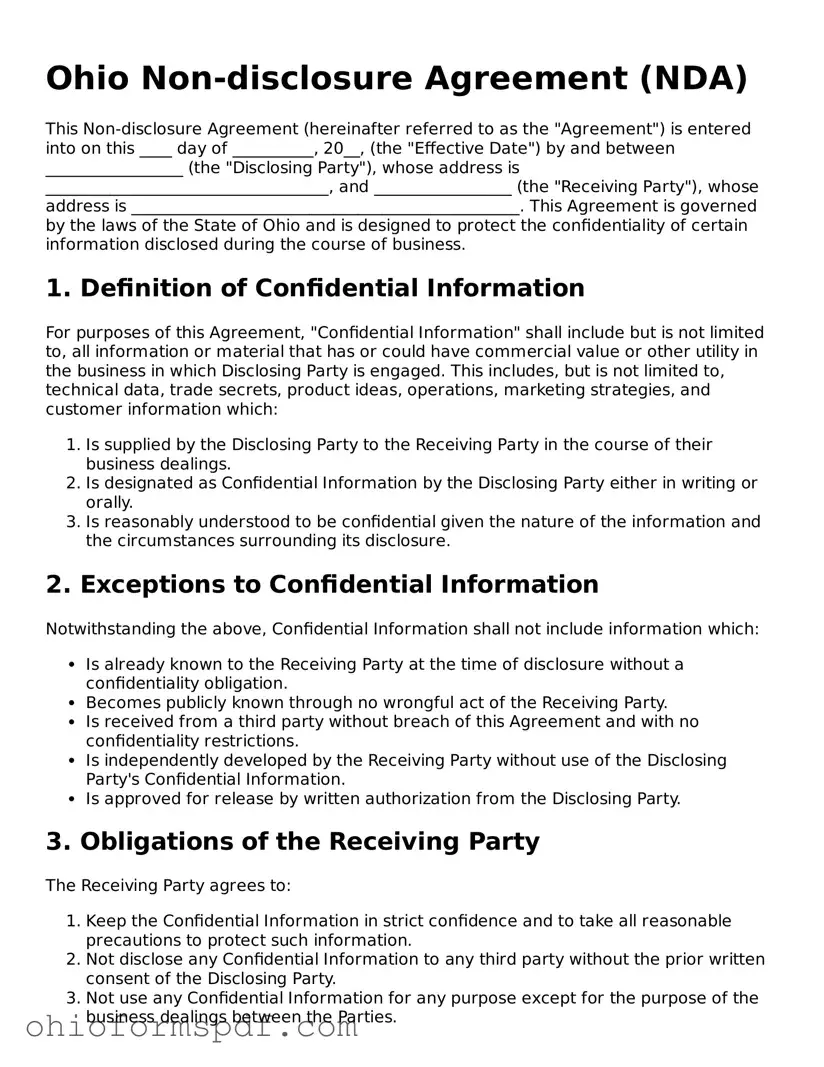Ohio Non-disclosure Agreement (NDA)
This Non-disclosure Agreement (hereinafter referred to as the "Agreement") is entered into on this ____ day of __________, 20__, (the "Effective Date") by and between _________________ (the "Disclosing Party"), whose address is ___________________________________, and _________________ (the "Receiving Party"), whose address is ________________________________________________. This Agreement is governed by the laws of the State of Ohio and is designed to protect the confidentiality of certain information disclosed during the course of business.
1. Definition of Confidential Information
For purposes of this Agreement, "Confidential Information" shall include but is not limited to, all information or material that has or could have commercial value or other utility in the business in which Disclosing Party is engaged. This includes, but is not limited to, technical data, trade secrets, product ideas, operations, marketing strategies, and customer information which:
- Is supplied by the Disclosing Party to the Receiving Party in the course of their business dealings.
- Is designated as Confidential Information by the Disclosing Party either in writing or orally.
- Is reasonably understood to be confidential given the nature of the information and the circumstances surrounding its disclosure.
2. Exceptions to Confidential Information
Notwithstanding the above, Confidential Information shall not include information which:
- Is already known to the Receiving Party at the time of disclosure without a confidentiality obligation.
- Becomes publicly known through no wrongful act of the Receiving Party.
- Is received from a third party without breach of this Agreement and with no confidentiality restrictions.
- Is independently developed by the Receiving Party without use of the Disclosing Party's Confidential Information.
- Is approved for release by written authorization from the Disclosing Party.
3. Obligations of the Receiving Party
The Receiving Party agrees to:
- Keep the Confidential Information in strict confidence and to take all reasonable precautions to protect such information.
- Not disclose any Confidential Information to any third party without the prior written consent of the Disclosing Party.
- Not use any Confidential Information for any purpose except for the purpose of the business dealings between the Parties.
- Limitedly disclose Confidential Information within its organization to employees who are required to know the information to carry out the business dealings, ensuring they are bound by confidentiality obligations similar to those in this Agreement.
4. Term
This Agreement shall commence on the Effective Date and shall continue in effect until ____________________ (the "Termination Date"), unless earlier terminated by mutual agreement of the Parties. Upon termination, or upon the Disclosing Party's written request, the Receiving Party shall promptly return or destroy all copies of Confidential Information received under this Agreement.
5. Governing Law
This Agreement shall be governed by and construed in accordance with the laws of the State of Ohio, without regard to its conflict of law principles. Any disputes under this Agreement shall be resolved in the state or federal courts located in Ohio, and the Parties consent to the jurisdiction of such courts.
6. Entire Agreement
This Agreement constitutes the entire agreement between the Parties with respect to the subject matter hereof and supersedes all prior or contemporaneous agreements, understandings, and negotiations, whether written or oral. This Agreement may not be amended except in writing signed by both Parties.
IN WITNESS WHEREOF, the Parties have executed this Agreement as of the Effective Date.
Disclosing Party:
Signature: ___________________________________
Printed Name: _________________________________
Title: ________________________________________
Date: ________________________________________
Receiving Party:
Signature: ___________________________________
Printed Name: _________________________________
Title: ________________________________________
Date: ________________________________________
